Analyzing Ethical Issues in End-of-Life Care: An ICU Nursing Case
VerifiedAdded on 2023/03/17
|11
|2964
|74
Case Study
AI Summary
This case study examines the ethical dilemmas encountered by nurses in end-of-life care within an intensive care unit (ICU) setting. It presents a scenario involving Mrs. Hellen, a 77-year-old patient with advanced bowel cancer, whose end-of-life care decisions become a point of conflict between her son's understanding of her wishes (no heroic measures) and her daughter's desire for aggressive palliative care. The case study analyzes the situation through the lens of ethical principles such as autonomy, beneficence, non-maleficence, and justice, highlighting the challenges healthcare professionals face in balancing patient autonomy with family desires and resource allocation. The paper discusses how the medical team navigated the conflicting demands, emphasizing the importance of communication, advance directives, and ethical considerations in end-of-life care decisions, while also providing insights into the roles and responsibilities of nurses in such complex situations. The document is available on Desklib, a platform providing study tools and solved assignments for students.
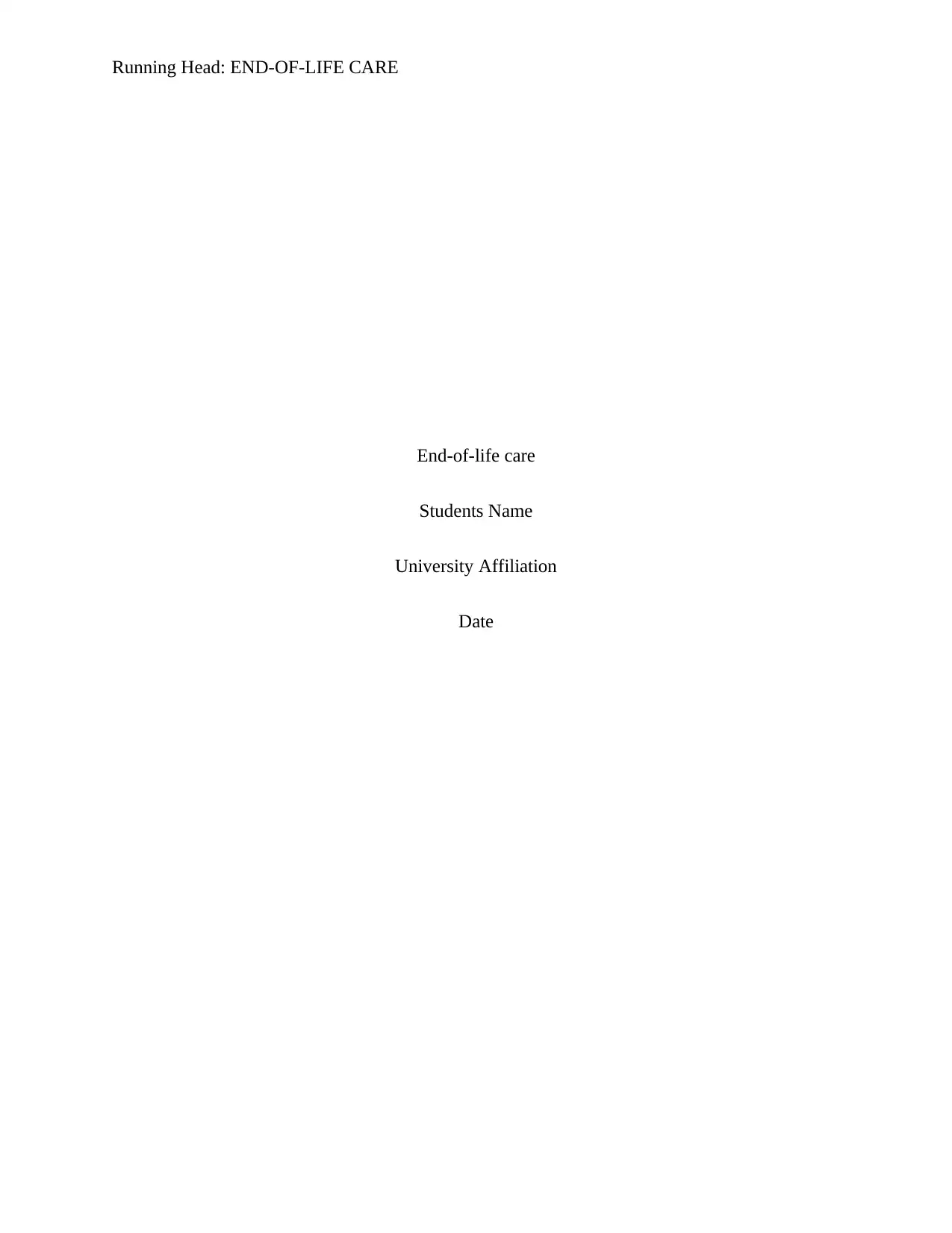
Running Head: END-OF-LIFE CARE
End-of-life care
Students Name
University Affiliation
Date
End-of-life care
Students Name
University Affiliation
Date
Paraphrase This Document
Need a fresh take? Get an instant paraphrase of this document with our AI Paraphraser
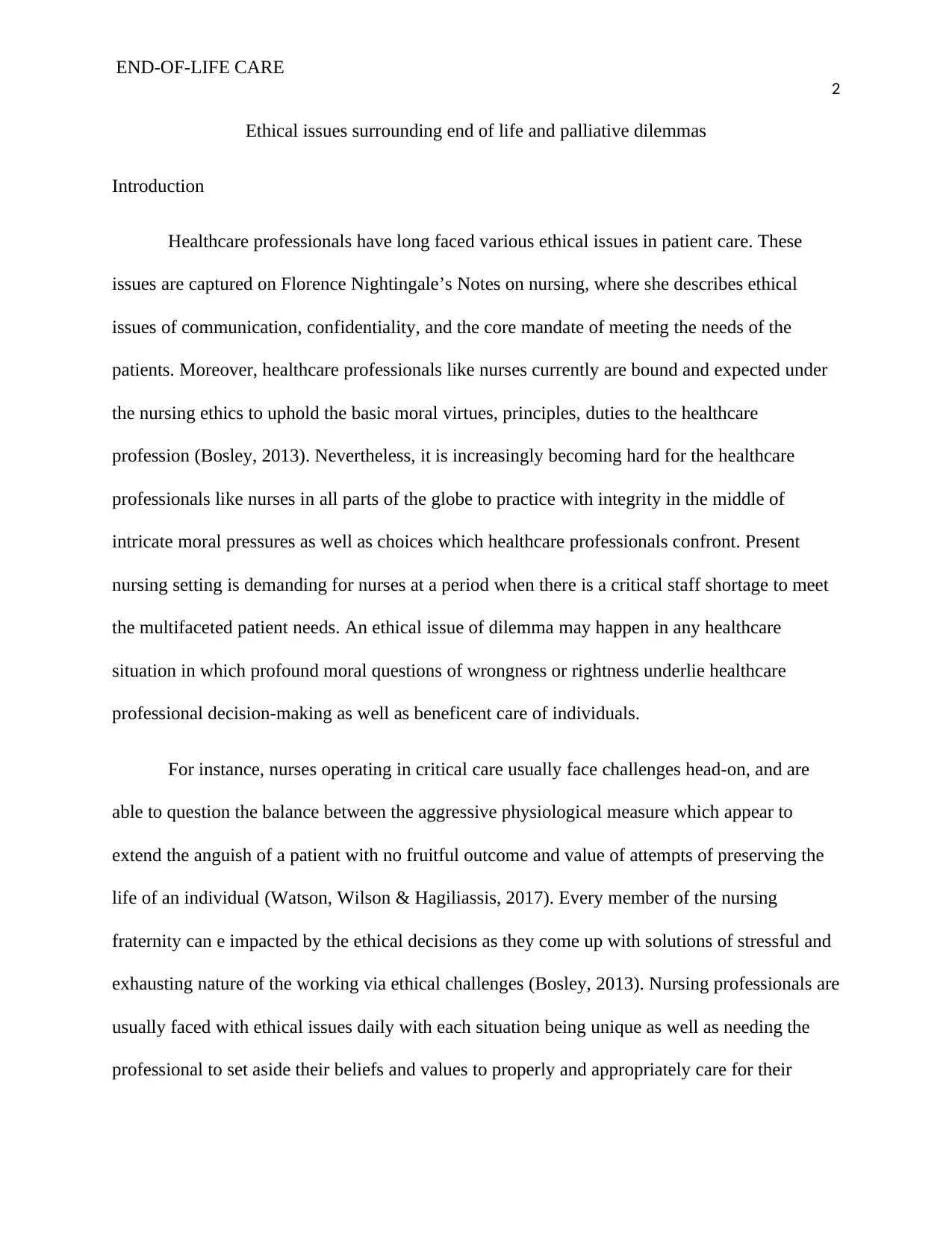
END-OF-LIFE CARE
2
Ethical issues surrounding end of life and palliative dilemmas
Introduction
Healthcare professionals have long faced various ethical issues in patient care. These
issues are captured on Florence Nightingale’s Notes on nursing, where she describes ethical
issues of communication, confidentiality, and the core mandate of meeting the needs of the
patients. Moreover, healthcare professionals like nurses currently are bound and expected under
the nursing ethics to uphold the basic moral virtues, principles, duties to the healthcare
profession (Bosley, 2013). Nevertheless, it is increasingly becoming hard for the healthcare
professionals like nurses in all parts of the globe to practice with integrity in the middle of
intricate moral pressures as well as choices which healthcare professionals confront. Present
nursing setting is demanding for nurses at a period when there is a critical staff shortage to meet
the multifaceted patient needs. An ethical issue of dilemma may happen in any healthcare
situation in which profound moral questions of wrongness or rightness underlie healthcare
professional decision-making as well as beneficent care of individuals.
For instance, nurses operating in critical care usually face challenges head-on, and are
able to question the balance between the aggressive physiological measure which appear to
extend the anguish of a patient with no fruitful outcome and value of attempts of preserving the
life of an individual (Watson, Wilson & Hagiliassis, 2017). Every member of the nursing
fraternity can e impacted by the ethical decisions as they come up with solutions of stressful and
exhausting nature of the working via ethical challenges (Bosley, 2013). Nursing professionals are
usually faced with ethical issues daily with each situation being unique as well as needing the
professional to set aside their beliefs and values to properly and appropriately care for their
2
Ethical issues surrounding end of life and palliative dilemmas
Introduction
Healthcare professionals have long faced various ethical issues in patient care. These
issues are captured on Florence Nightingale’s Notes on nursing, where she describes ethical
issues of communication, confidentiality, and the core mandate of meeting the needs of the
patients. Moreover, healthcare professionals like nurses currently are bound and expected under
the nursing ethics to uphold the basic moral virtues, principles, duties to the healthcare
profession (Bosley, 2013). Nevertheless, it is increasingly becoming hard for the healthcare
professionals like nurses in all parts of the globe to practice with integrity in the middle of
intricate moral pressures as well as choices which healthcare professionals confront. Present
nursing setting is demanding for nurses at a period when there is a critical staff shortage to meet
the multifaceted patient needs. An ethical issue of dilemma may happen in any healthcare
situation in which profound moral questions of wrongness or rightness underlie healthcare
professional decision-making as well as beneficent care of individuals.
For instance, nurses operating in critical care usually face challenges head-on, and are
able to question the balance between the aggressive physiological measure which appear to
extend the anguish of a patient with no fruitful outcome and value of attempts of preserving the
life of an individual (Watson, Wilson & Hagiliassis, 2017). Every member of the nursing
fraternity can e impacted by the ethical decisions as they come up with solutions of stressful and
exhausting nature of the working via ethical challenges (Bosley, 2013). Nursing professionals are
usually faced with ethical issues daily with each situation being unique as well as needing the
professional to set aside their beliefs and values to properly and appropriately care for their
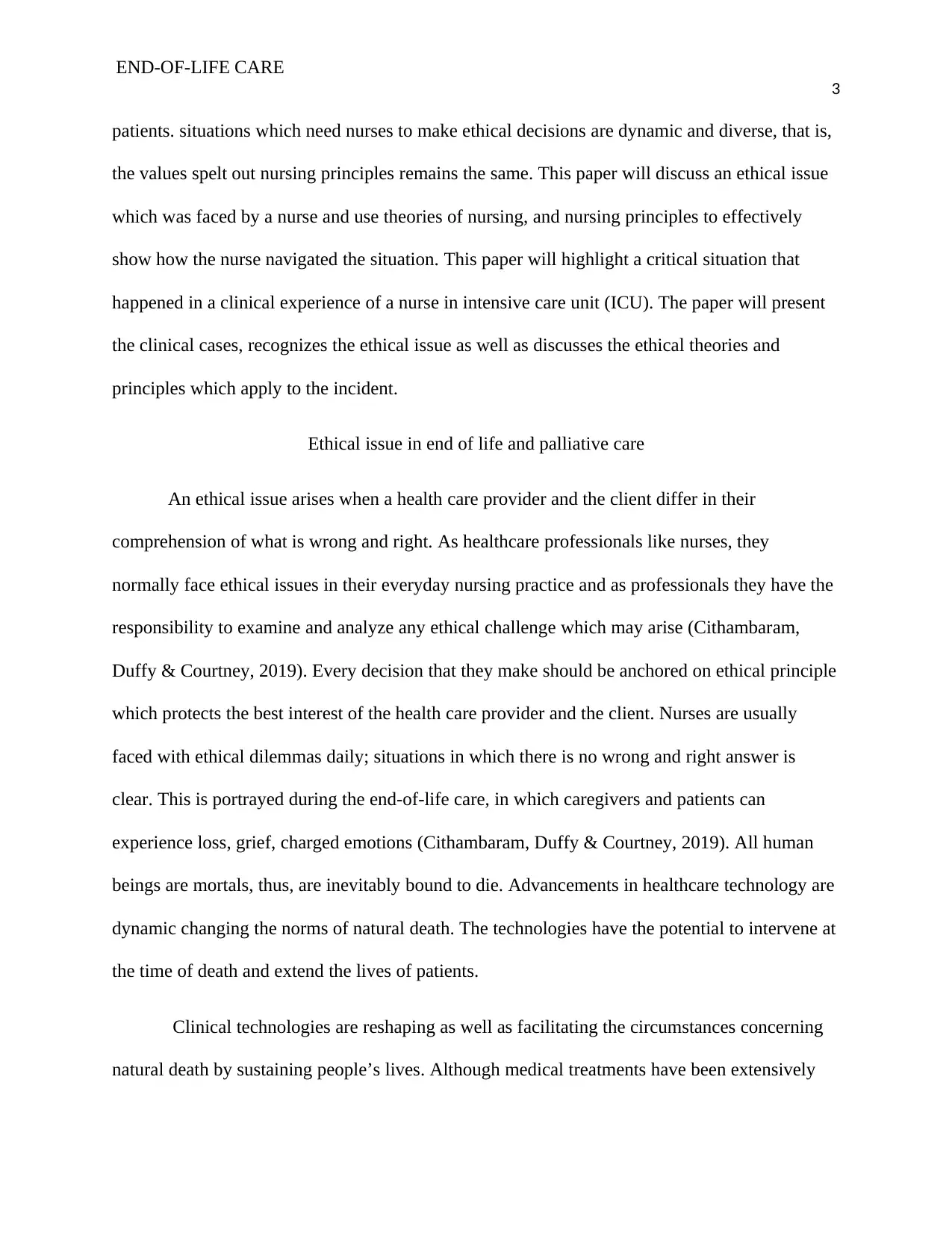
END-OF-LIFE CARE
3
patients. situations which need nurses to make ethical decisions are dynamic and diverse, that is,
the values spelt out nursing principles remains the same. This paper will discuss an ethical issue
which was faced by a nurse and use theories of nursing, and nursing principles to effectively
show how the nurse navigated the situation. This paper will highlight a critical situation that
happened in a clinical experience of a nurse in intensive care unit (ICU). The paper will present
the clinical cases, recognizes the ethical issue as well as discusses the ethical theories and
principles which apply to the incident.
Ethical issue in end of life and palliative care
An ethical issue arises when a health care provider and the client differ in their
comprehension of what is wrong and right. As healthcare professionals like nurses, they
normally face ethical issues in their everyday nursing practice and as professionals they have the
responsibility to examine and analyze any ethical challenge which may arise (Cithambaram,
Duffy & Courtney, 2019). Every decision that they make should be anchored on ethical principle
which protects the best interest of the health care provider and the client. Nurses are usually
faced with ethical dilemmas daily; situations in which there is no wrong and right answer is
clear. This is portrayed during the end-of-life care, in which caregivers and patients can
experience loss, grief, charged emotions (Cithambaram, Duffy & Courtney, 2019). All human
beings are mortals, thus, are inevitably bound to die. Advancements in healthcare technology are
dynamic changing the norms of natural death. The technologies have the potential to intervene at
the time of death and extend the lives of patients.
Clinical technologies are reshaping as well as facilitating the circumstances concerning
natural death by sustaining people’s lives. Although medical treatments have been extensively
3
patients. situations which need nurses to make ethical decisions are dynamic and diverse, that is,
the values spelt out nursing principles remains the same. This paper will discuss an ethical issue
which was faced by a nurse and use theories of nursing, and nursing principles to effectively
show how the nurse navigated the situation. This paper will highlight a critical situation that
happened in a clinical experience of a nurse in intensive care unit (ICU). The paper will present
the clinical cases, recognizes the ethical issue as well as discusses the ethical theories and
principles which apply to the incident.
Ethical issue in end of life and palliative care
An ethical issue arises when a health care provider and the client differ in their
comprehension of what is wrong and right. As healthcare professionals like nurses, they
normally face ethical issues in their everyday nursing practice and as professionals they have the
responsibility to examine and analyze any ethical challenge which may arise (Cithambaram,
Duffy & Courtney, 2019). Every decision that they make should be anchored on ethical principle
which protects the best interest of the health care provider and the client. Nurses are usually
faced with ethical dilemmas daily; situations in which there is no wrong and right answer is
clear. This is portrayed during the end-of-life care, in which caregivers and patients can
experience loss, grief, charged emotions (Cithambaram, Duffy & Courtney, 2019). All human
beings are mortals, thus, are inevitably bound to die. Advancements in healthcare technology are
dynamic changing the norms of natural death. The technologies have the potential to intervene at
the time of death and extend the lives of patients.
Clinical technologies are reshaping as well as facilitating the circumstances concerning
natural death by sustaining people’s lives. Although medical treatments have been extensively
⊘ This is a preview!⊘
Do you want full access?
Subscribe today to unlock all pages.

Trusted by 1+ million students worldwide
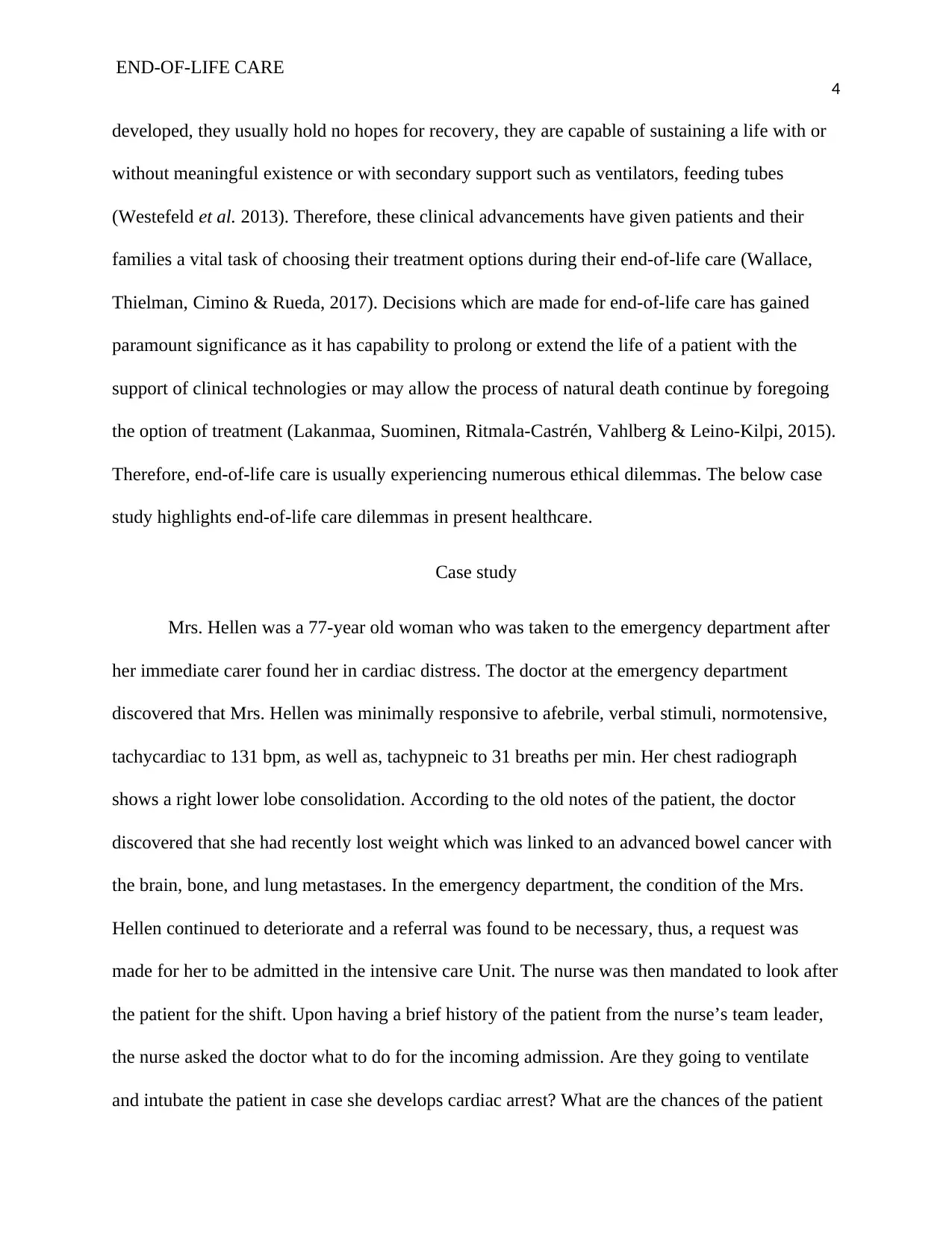
END-OF-LIFE CARE
4
developed, they usually hold no hopes for recovery, they are capable of sustaining a life with or
without meaningful existence or with secondary support such as ventilators, feeding tubes
(Westefeld et al. 2013). Therefore, these clinical advancements have given patients and their
families a vital task of choosing their treatment options during their end-of-life care (Wallace,
Thielman, Cimino & Rueda, 2017). Decisions which are made for end-of-life care has gained
paramount significance as it has capability to prolong or extend the life of a patient with the
support of clinical technologies or may allow the process of natural death continue by foregoing
the option of treatment (Lakanmaa, Suominen, Ritmala-Castrén, Vahlberg & Leino-Kilpi, 2015).
Therefore, end-of-life care is usually experiencing numerous ethical dilemmas. The below case
study highlights end-of-life care dilemmas in present healthcare.
Case study
Mrs. Hellen was a 77-year old woman who was taken to the emergency department after
her immediate carer found her in cardiac distress. The doctor at the emergency department
discovered that Mrs. Hellen was minimally responsive to afebrile, verbal stimuli, normotensive,
tachycardiac to 131 bpm, as well as, tachypneic to 31 breaths per min. Her chest radiograph
shows a right lower lobe consolidation. According to the old notes of the patient, the doctor
discovered that she had recently lost weight which was linked to an advanced bowel cancer with
the brain, bone, and lung metastases. In the emergency department, the condition of the Mrs.
Hellen continued to deteriorate and a referral was found to be necessary, thus, a request was
made for her to be admitted in the intensive care Unit. The nurse was then mandated to look after
the patient for the shift. Upon having a brief history of the patient from the nurse’s team leader,
the nurse asked the doctor what to do for the incoming admission. Are they going to ventilate
and intubate the patient in case she develops cardiac arrest? What are the chances of the patient
4
developed, they usually hold no hopes for recovery, they are capable of sustaining a life with or
without meaningful existence or with secondary support such as ventilators, feeding tubes
(Westefeld et al. 2013). Therefore, these clinical advancements have given patients and their
families a vital task of choosing their treatment options during their end-of-life care (Wallace,
Thielman, Cimino & Rueda, 2017). Decisions which are made for end-of-life care has gained
paramount significance as it has capability to prolong or extend the life of a patient with the
support of clinical technologies or may allow the process of natural death continue by foregoing
the option of treatment (Lakanmaa, Suominen, Ritmala-Castrén, Vahlberg & Leino-Kilpi, 2015).
Therefore, end-of-life care is usually experiencing numerous ethical dilemmas. The below case
study highlights end-of-life care dilemmas in present healthcare.
Case study
Mrs. Hellen was a 77-year old woman who was taken to the emergency department after
her immediate carer found her in cardiac distress. The doctor at the emergency department
discovered that Mrs. Hellen was minimally responsive to afebrile, verbal stimuli, normotensive,
tachycardiac to 131 bpm, as well as, tachypneic to 31 breaths per min. Her chest radiograph
shows a right lower lobe consolidation. According to the old notes of the patient, the doctor
discovered that she had recently lost weight which was linked to an advanced bowel cancer with
the brain, bone, and lung metastases. In the emergency department, the condition of the Mrs.
Hellen continued to deteriorate and a referral was found to be necessary, thus, a request was
made for her to be admitted in the intensive care Unit. The nurse was then mandated to look after
the patient for the shift. Upon having a brief history of the patient from the nurse’s team leader,
the nurse asked the doctor what to do for the incoming admission. Are they going to ventilate
and intubate the patient in case she develops cardiac arrest? What are the chances of the patient
Paraphrase This Document
Need a fresh take? Get an instant paraphrase of this document with our AI Paraphraser
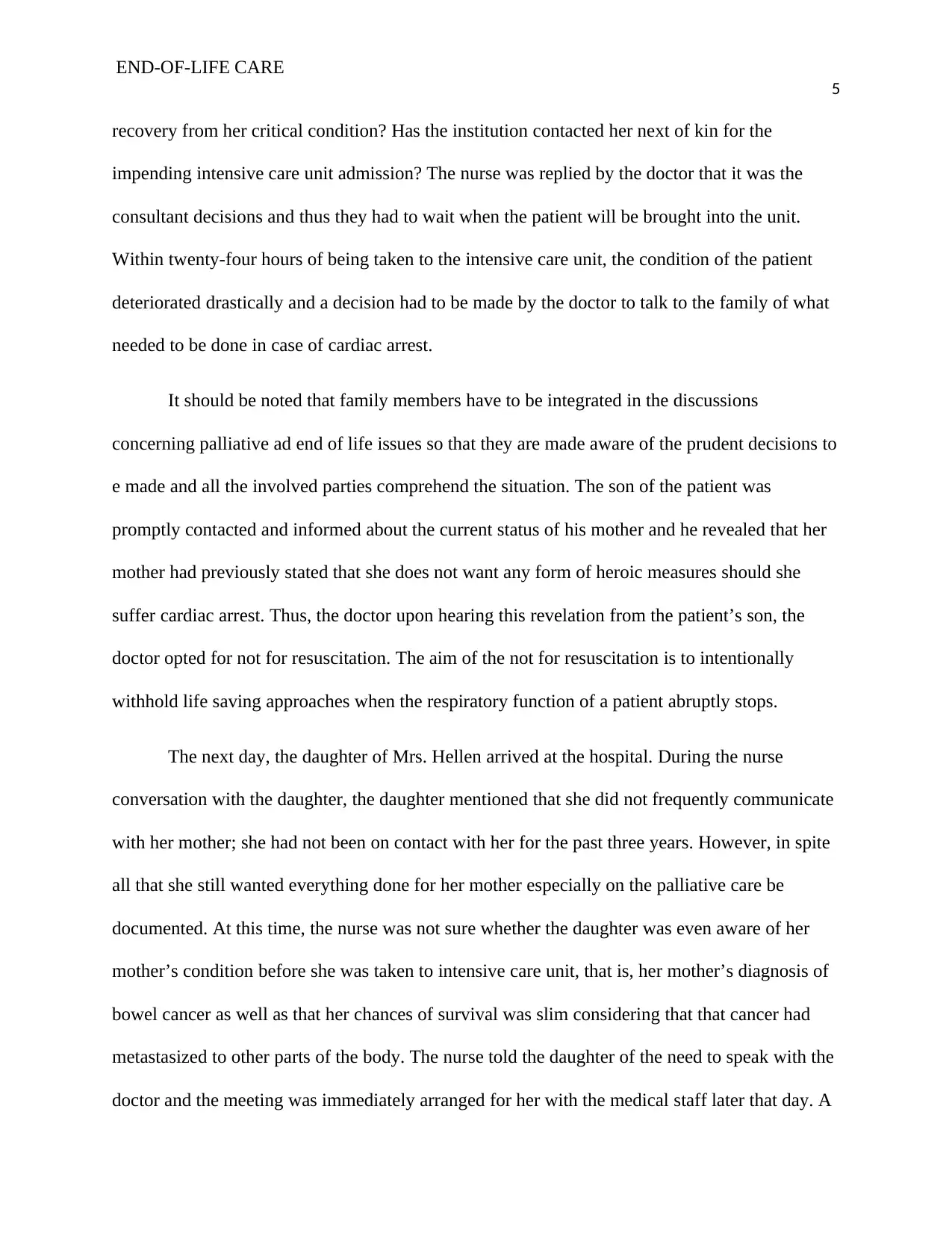
END-OF-LIFE CARE
5
recovery from her critical condition? Has the institution contacted her next of kin for the
impending intensive care unit admission? The nurse was replied by the doctor that it was the
consultant decisions and thus they had to wait when the patient will be brought into the unit.
Within twenty-four hours of being taken to the intensive care unit, the condition of the patient
deteriorated drastically and a decision had to be made by the doctor to talk to the family of what
needed to be done in case of cardiac arrest.
It should be noted that family members have to be integrated in the discussions
concerning palliative ad end of life issues so that they are made aware of the prudent decisions to
e made and all the involved parties comprehend the situation. The son of the patient was
promptly contacted and informed about the current status of his mother and he revealed that her
mother had previously stated that she does not want any form of heroic measures should she
suffer cardiac arrest. Thus, the doctor upon hearing this revelation from the patient’s son, the
doctor opted for not for resuscitation. The aim of the not for resuscitation is to intentionally
withhold life saving approaches when the respiratory function of a patient abruptly stops.
The next day, the daughter of Mrs. Hellen arrived at the hospital. During the nurse
conversation with the daughter, the daughter mentioned that she did not frequently communicate
with her mother; she had not been on contact with her for the past three years. However, in spite
all that she still wanted everything done for her mother especially on the palliative care be
documented. At this time, the nurse was not sure whether the daughter was even aware of her
mother’s condition before she was taken to intensive care unit, that is, her mother’s diagnosis of
bowel cancer as well as that her chances of survival was slim considering that that cancer had
metastasized to other parts of the body. The nurse told the daughter of the need to speak with the
doctor and the meeting was immediately arranged for her with the medical staff later that day. A
5
recovery from her critical condition? Has the institution contacted her next of kin for the
impending intensive care unit admission? The nurse was replied by the doctor that it was the
consultant decisions and thus they had to wait when the patient will be brought into the unit.
Within twenty-four hours of being taken to the intensive care unit, the condition of the patient
deteriorated drastically and a decision had to be made by the doctor to talk to the family of what
needed to be done in case of cardiac arrest.
It should be noted that family members have to be integrated in the discussions
concerning palliative ad end of life issues so that they are made aware of the prudent decisions to
e made and all the involved parties comprehend the situation. The son of the patient was
promptly contacted and informed about the current status of his mother and he revealed that her
mother had previously stated that she does not want any form of heroic measures should she
suffer cardiac arrest. Thus, the doctor upon hearing this revelation from the patient’s son, the
doctor opted for not for resuscitation. The aim of the not for resuscitation is to intentionally
withhold life saving approaches when the respiratory function of a patient abruptly stops.
The next day, the daughter of Mrs. Hellen arrived at the hospital. During the nurse
conversation with the daughter, the daughter mentioned that she did not frequently communicate
with her mother; she had not been on contact with her for the past three years. However, in spite
all that she still wanted everything done for her mother especially on the palliative care be
documented. At this time, the nurse was not sure whether the daughter was even aware of her
mother’s condition before she was taken to intensive care unit, that is, her mother’s diagnosis of
bowel cancer as well as that her chances of survival was slim considering that that cancer had
metastasized to other parts of the body. The nurse told the daughter of the need to speak with the
doctor and the meeting was immediately arranged for her with the medical staff later that day. A
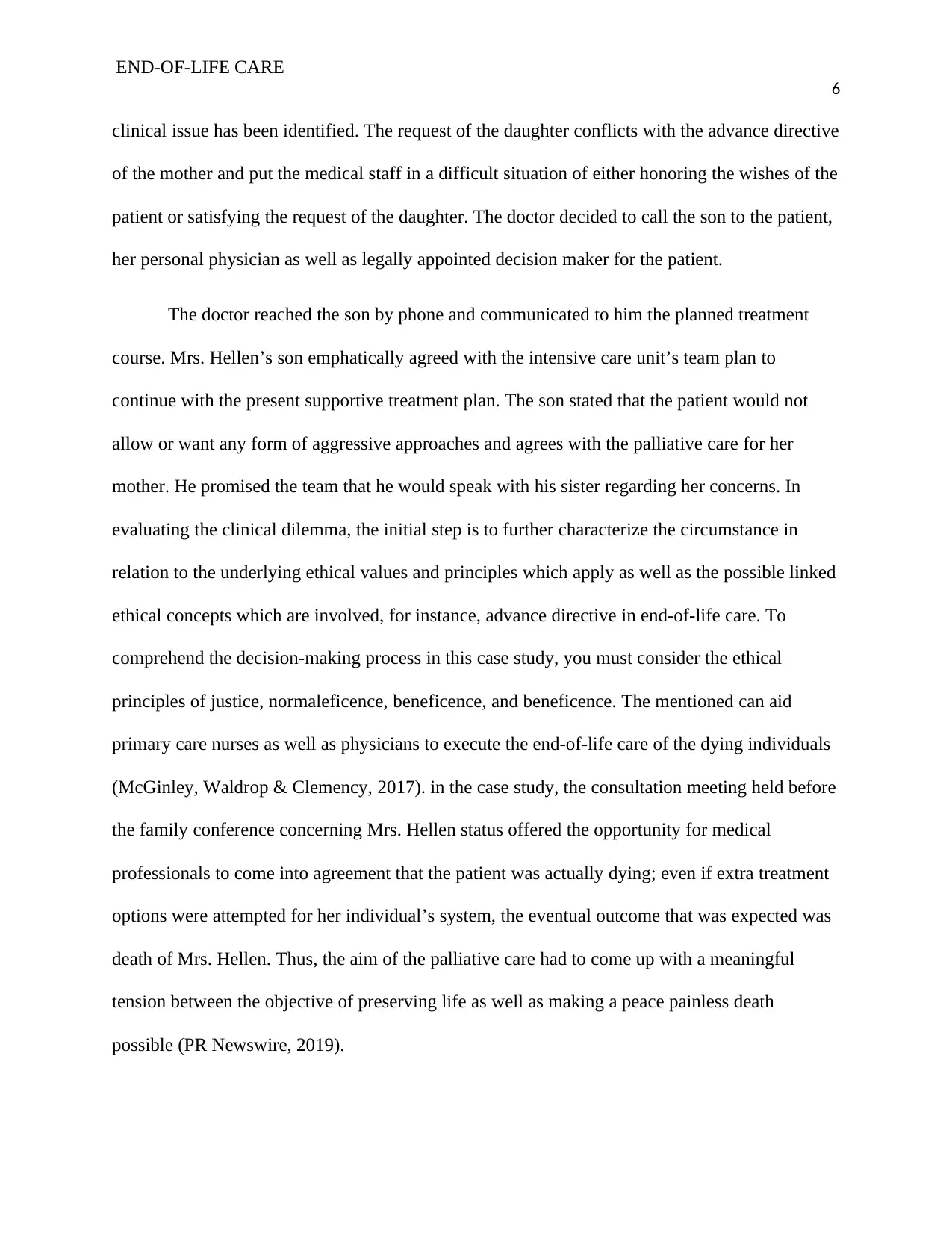
END-OF-LIFE CARE
6
clinical issue has been identified. The request of the daughter conflicts with the advance directive
of the mother and put the medical staff in a difficult situation of either honoring the wishes of the
patient or satisfying the request of the daughter. The doctor decided to call the son to the patient,
her personal physician as well as legally appointed decision maker for the patient.
The doctor reached the son by phone and communicated to him the planned treatment
course. Mrs. Hellen’s son emphatically agreed with the intensive care unit’s team plan to
continue with the present supportive treatment plan. The son stated that the patient would not
allow or want any form of aggressive approaches and agrees with the palliative care for her
mother. He promised the team that he would speak with his sister regarding her concerns. In
evaluating the clinical dilemma, the initial step is to further characterize the circumstance in
relation to the underlying ethical values and principles which apply as well as the possible linked
ethical concepts which are involved, for instance, advance directive in end-of-life care. To
comprehend the decision-making process in this case study, you must consider the ethical
principles of justice, normaleficence, beneficence, and beneficence. The mentioned can aid
primary care nurses as well as physicians to execute the end-of-life care of the dying individuals
(McGinley, Waldrop & Clemency, 2017). in the case study, the consultation meeting held before
the family conference concerning Mrs. Hellen status offered the opportunity for medical
professionals to come into agreement that the patient was actually dying; even if extra treatment
options were attempted for her individual’s system, the eventual outcome that was expected was
death of Mrs. Hellen. Thus, the aim of the palliative care had to come up with a meaningful
tension between the objective of preserving life as well as making a peace painless death
possible (PR Newswire, 2019).
6
clinical issue has been identified. The request of the daughter conflicts with the advance directive
of the mother and put the medical staff in a difficult situation of either honoring the wishes of the
patient or satisfying the request of the daughter. The doctor decided to call the son to the patient,
her personal physician as well as legally appointed decision maker for the patient.
The doctor reached the son by phone and communicated to him the planned treatment
course. Mrs. Hellen’s son emphatically agreed with the intensive care unit’s team plan to
continue with the present supportive treatment plan. The son stated that the patient would not
allow or want any form of aggressive approaches and agrees with the palliative care for her
mother. He promised the team that he would speak with his sister regarding her concerns. In
evaluating the clinical dilemma, the initial step is to further characterize the circumstance in
relation to the underlying ethical values and principles which apply as well as the possible linked
ethical concepts which are involved, for instance, advance directive in end-of-life care. To
comprehend the decision-making process in this case study, you must consider the ethical
principles of justice, normaleficence, beneficence, and beneficence. The mentioned can aid
primary care nurses as well as physicians to execute the end-of-life care of the dying individuals
(McGinley, Waldrop & Clemency, 2017). in the case study, the consultation meeting held before
the family conference concerning Mrs. Hellen status offered the opportunity for medical
professionals to come into agreement that the patient was actually dying; even if extra treatment
options were attempted for her individual’s system, the eventual outcome that was expected was
death of Mrs. Hellen. Thus, the aim of the palliative care had to come up with a meaningful
tension between the objective of preserving life as well as making a peace painless death
possible (PR Newswire, 2019).
⊘ This is a preview!⊘
Do you want full access?
Subscribe today to unlock all pages.

Trusted by 1+ million students worldwide
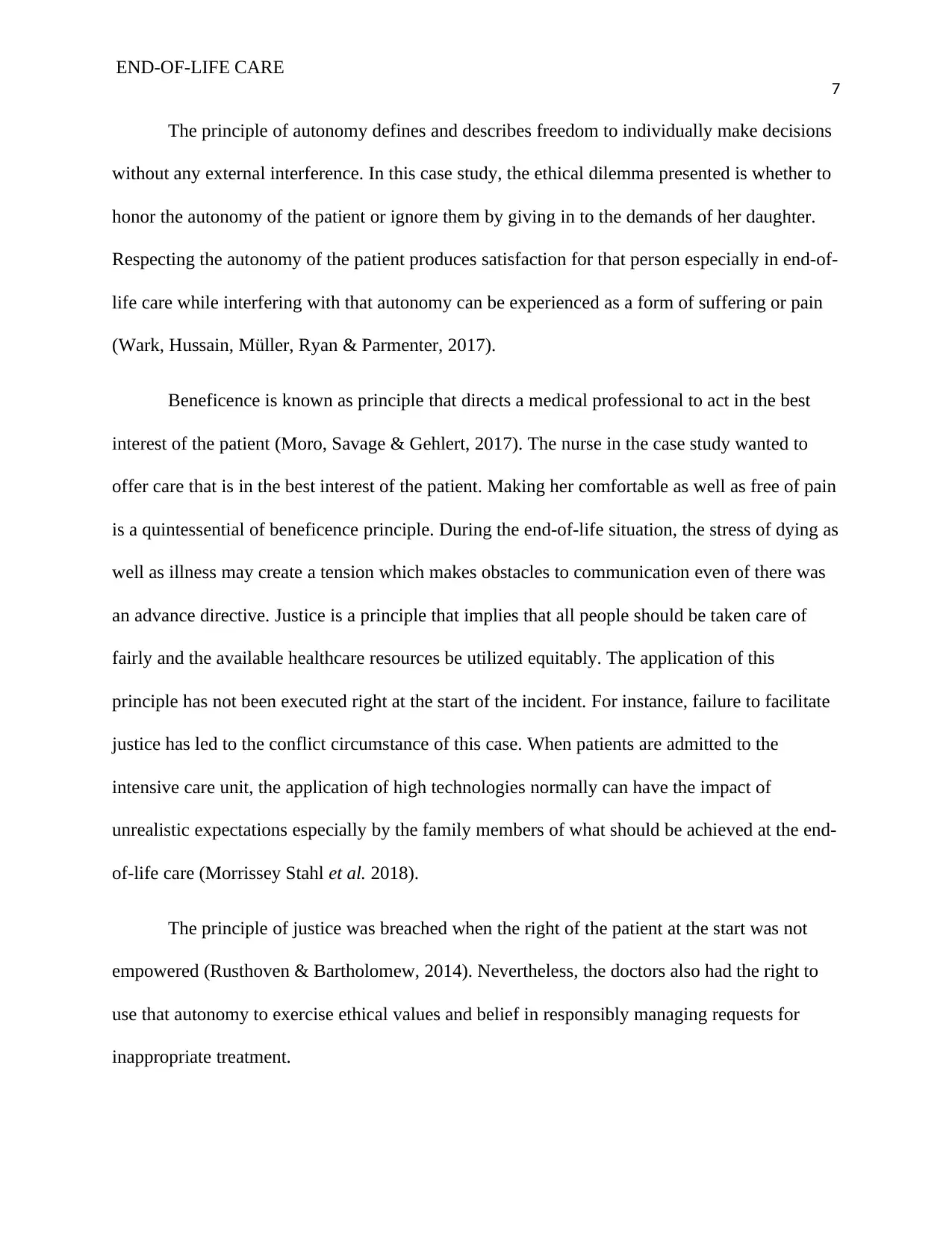
END-OF-LIFE CARE
7
The principle of autonomy defines and describes freedom to individually make decisions
without any external interference. In this case study, the ethical dilemma presented is whether to
honor the autonomy of the patient or ignore them by giving in to the demands of her daughter.
Respecting the autonomy of the patient produces satisfaction for that person especially in end-of-
life care while interfering with that autonomy can be experienced as a form of suffering or pain
(Wark, Hussain, Müller, Ryan & Parmenter, 2017).
Beneficence is known as principle that directs a medical professional to act in the best
interest of the patient (Moro, Savage & Gehlert, 2017). The nurse in the case study wanted to
offer care that is in the best interest of the patient. Making her comfortable as well as free of pain
is a quintessential of beneficence principle. During the end-of-life situation, the stress of dying as
well as illness may create a tension which makes obstacles to communication even of there was
an advance directive. Justice is a principle that implies that all people should be taken care of
fairly and the available healthcare resources be utilized equitably. The application of this
principle has not been executed right at the start of the incident. For instance, failure to facilitate
justice has led to the conflict circumstance of this case. When patients are admitted to the
intensive care unit, the application of high technologies normally can have the impact of
unrealistic expectations especially by the family members of what should be achieved at the end-
of-life care (Morrissey Stahl et al. 2018).
The principle of justice was breached when the right of the patient at the start was not
empowered (Rusthoven & Bartholomew, 2014). Nevertheless, the doctors also had the right to
use that autonomy to exercise ethical values and belief in responsibly managing requests for
inappropriate treatment.
7
The principle of autonomy defines and describes freedom to individually make decisions
without any external interference. In this case study, the ethical dilemma presented is whether to
honor the autonomy of the patient or ignore them by giving in to the demands of her daughter.
Respecting the autonomy of the patient produces satisfaction for that person especially in end-of-
life care while interfering with that autonomy can be experienced as a form of suffering or pain
(Wark, Hussain, Müller, Ryan & Parmenter, 2017).
Beneficence is known as principle that directs a medical professional to act in the best
interest of the patient (Moro, Savage & Gehlert, 2017). The nurse in the case study wanted to
offer care that is in the best interest of the patient. Making her comfortable as well as free of pain
is a quintessential of beneficence principle. During the end-of-life situation, the stress of dying as
well as illness may create a tension which makes obstacles to communication even of there was
an advance directive. Justice is a principle that implies that all people should be taken care of
fairly and the available healthcare resources be utilized equitably. The application of this
principle has not been executed right at the start of the incident. For instance, failure to facilitate
justice has led to the conflict circumstance of this case. When patients are admitted to the
intensive care unit, the application of high technologies normally can have the impact of
unrealistic expectations especially by the family members of what should be achieved at the end-
of-life care (Morrissey Stahl et al. 2018).
The principle of justice was breached when the right of the patient at the start was not
empowered (Rusthoven & Bartholomew, 2014). Nevertheless, the doctors also had the right to
use that autonomy to exercise ethical values and belief in responsibly managing requests for
inappropriate treatment.
Paraphrase This Document
Need a fresh take? Get an instant paraphrase of this document with our AI Paraphraser
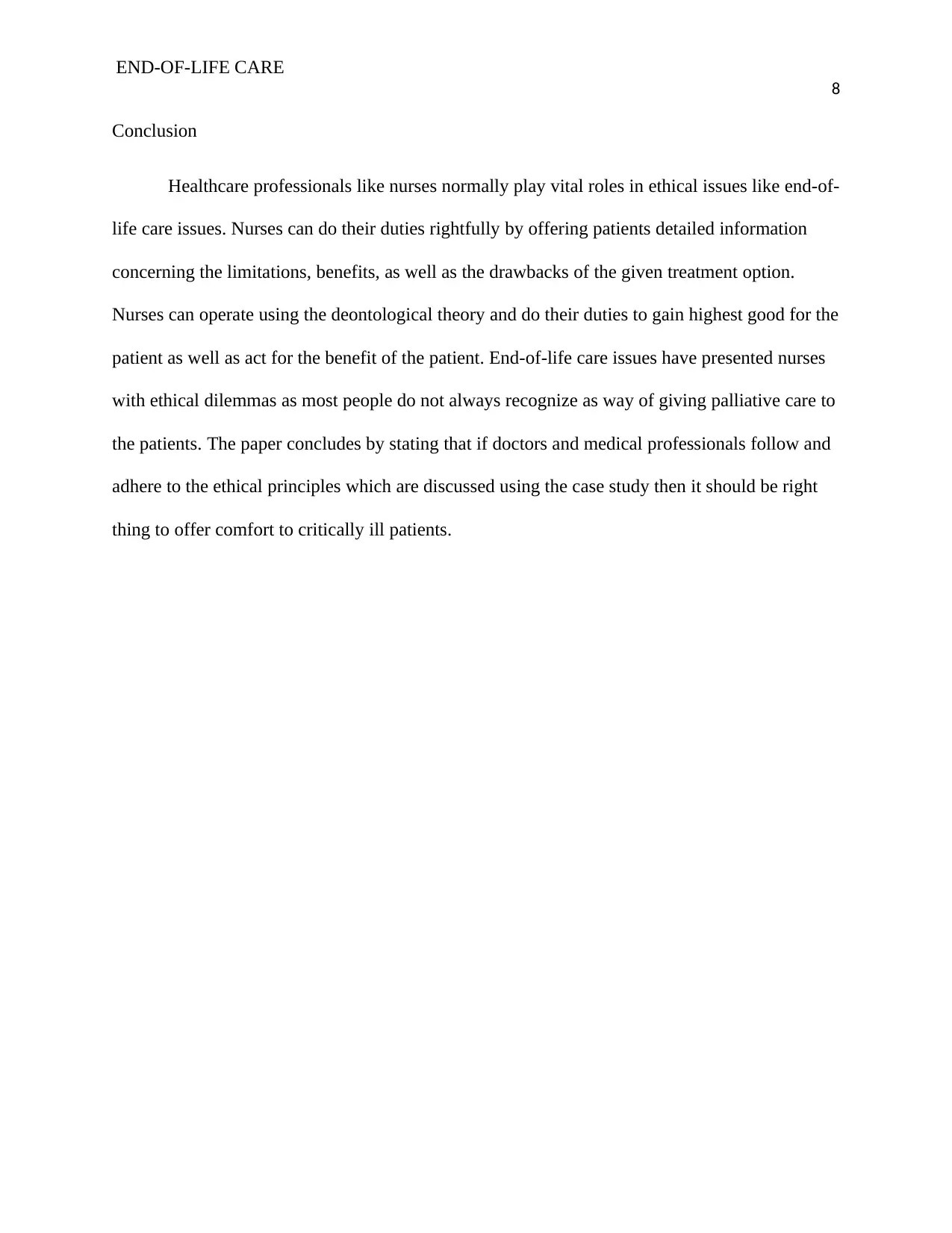
END-OF-LIFE CARE
8
Conclusion
Healthcare professionals like nurses normally play vital roles in ethical issues like end-of-
life care issues. Nurses can do their duties rightfully by offering patients detailed information
concerning the limitations, benefits, as well as the drawbacks of the given treatment option.
Nurses can operate using the deontological theory and do their duties to gain highest good for the
patient as well as act for the benefit of the patient. End-of-life care issues have presented nurses
with ethical dilemmas as most people do not always recognize as way of giving palliative care to
the patients. The paper concludes by stating that if doctors and medical professionals follow and
adhere to the ethical principles which are discussed using the case study then it should be right
thing to offer comfort to critically ill patients.
8
Conclusion
Healthcare professionals like nurses normally play vital roles in ethical issues like end-of-
life care issues. Nurses can do their duties rightfully by offering patients detailed information
concerning the limitations, benefits, as well as the drawbacks of the given treatment option.
Nurses can operate using the deontological theory and do their duties to gain highest good for the
patient as well as act for the benefit of the patient. End-of-life care issues have presented nurses
with ethical dilemmas as most people do not always recognize as way of giving palliative care to
the patients. The paper concludes by stating that if doctors and medical professionals follow and
adhere to the ethical principles which are discussed using the case study then it should be right
thing to offer comfort to critically ill patients.
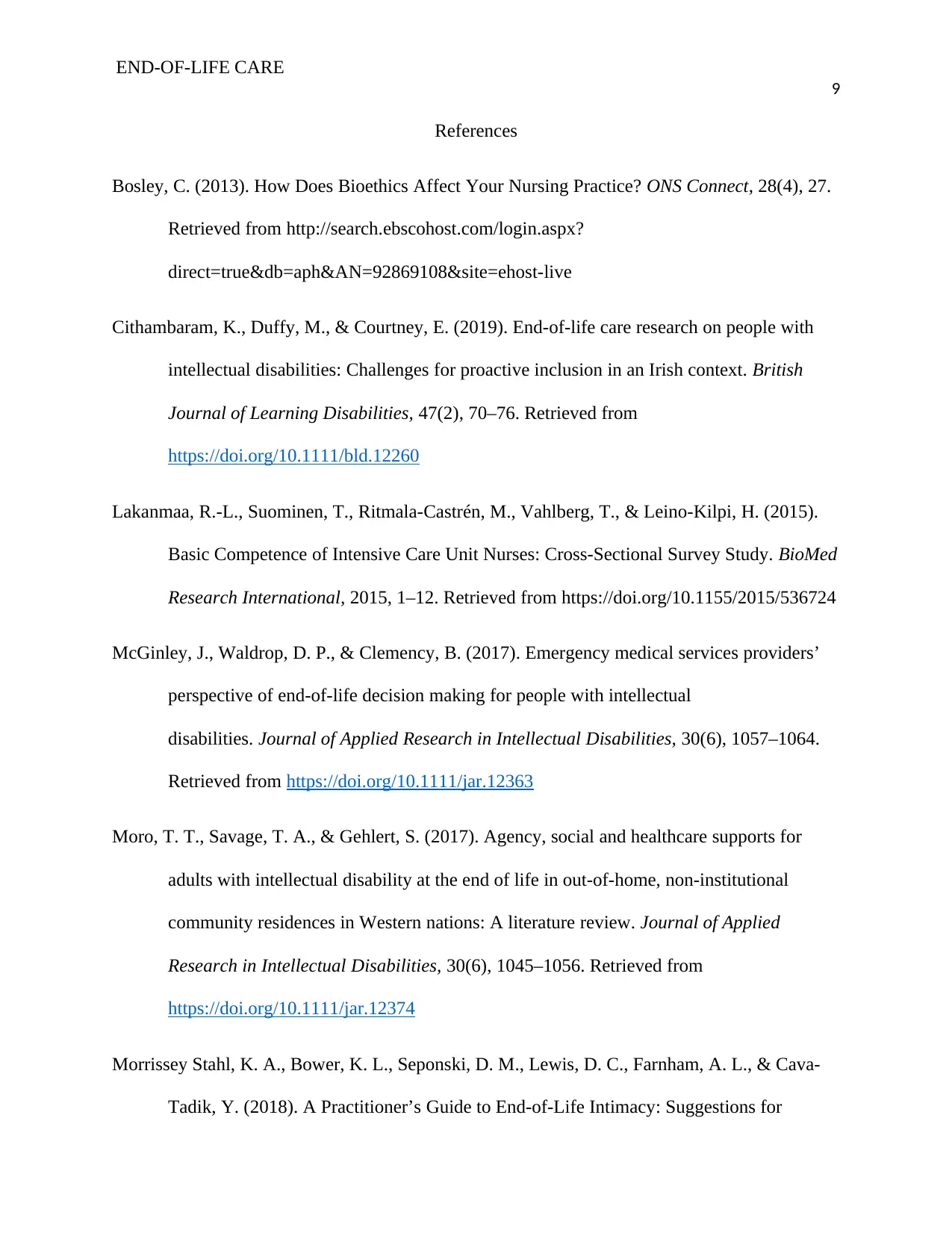
END-OF-LIFE CARE
9
References
Bosley, C. (2013). How Does Bioethics Affect Your Nursing Practice? ONS Connect, 28(4), 27.
Retrieved from http://search.ebscohost.com/login.aspx?
direct=true&db=aph&AN=92869108&site=ehost-live
Cithambaram, K., Duffy, M., & Courtney, E. (2019). End‐of‐life care research on people with
intellectual disabilities: Challenges for proactive inclusion in an Irish context. British
Journal of Learning Disabilities, 47(2), 70–76. Retrieved from
https://doi.org/10.1111/bld.12260
Lakanmaa, R.-L., Suominen, T., Ritmala-Castrén, M., Vahlberg, T., & Leino-Kilpi, H. (2015).
Basic Competence of Intensive Care Unit Nurses: Cross-Sectional Survey Study. BioMed
Research International, 2015, 1–12. Retrieved from https://doi.org/10.1155/2015/536724
McGinley, J., Waldrop, D. P., & Clemency, B. (2017). Emergency medical services providers’
perspective of end-of-life decision making for people with intellectual
disabilities. Journal of Applied Research in Intellectual Disabilities, 30(6), 1057–1064.
Retrieved from https://doi.org/10.1111/jar.12363
Moro, T. T., Savage, T. A., & Gehlert, S. (2017). Agency, social and healthcare supports for
adults with intellectual disability at the end of life in out-of-home, non-institutional
community residences in Western nations: A literature review. Journal of Applied
Research in Intellectual Disabilities, 30(6), 1045–1056. Retrieved from
https://doi.org/10.1111/jar.12374
Morrissey Stahl, K. A., Bower, K. L., Seponski, D. M., Lewis, D. C., Farnham, A. L., & Cava-
Tadik, Y. (2018). A Practitioner’s Guide to End-of-Life Intimacy: Suggestions for
9
References
Bosley, C. (2013). How Does Bioethics Affect Your Nursing Practice? ONS Connect, 28(4), 27.
Retrieved from http://search.ebscohost.com/login.aspx?
direct=true&db=aph&AN=92869108&site=ehost-live
Cithambaram, K., Duffy, M., & Courtney, E. (2019). End‐of‐life care research on people with
intellectual disabilities: Challenges for proactive inclusion in an Irish context. British
Journal of Learning Disabilities, 47(2), 70–76. Retrieved from
https://doi.org/10.1111/bld.12260
Lakanmaa, R.-L., Suominen, T., Ritmala-Castrén, M., Vahlberg, T., & Leino-Kilpi, H. (2015).
Basic Competence of Intensive Care Unit Nurses: Cross-Sectional Survey Study. BioMed
Research International, 2015, 1–12. Retrieved from https://doi.org/10.1155/2015/536724
McGinley, J., Waldrop, D. P., & Clemency, B. (2017). Emergency medical services providers’
perspective of end-of-life decision making for people with intellectual
disabilities. Journal of Applied Research in Intellectual Disabilities, 30(6), 1057–1064.
Retrieved from https://doi.org/10.1111/jar.12363
Moro, T. T., Savage, T. A., & Gehlert, S. (2017). Agency, social and healthcare supports for
adults with intellectual disability at the end of life in out-of-home, non-institutional
community residences in Western nations: A literature review. Journal of Applied
Research in Intellectual Disabilities, 30(6), 1045–1056. Retrieved from
https://doi.org/10.1111/jar.12374
Morrissey Stahl, K. A., Bower, K. L., Seponski, D. M., Lewis, D. C., Farnham, A. L., & Cava-
Tadik, Y. (2018). A Practitioner’s Guide to End-of-Life Intimacy: Suggestions for
⊘ This is a preview!⊘
Do you want full access?
Subscribe today to unlock all pages.

Trusted by 1+ million students worldwide
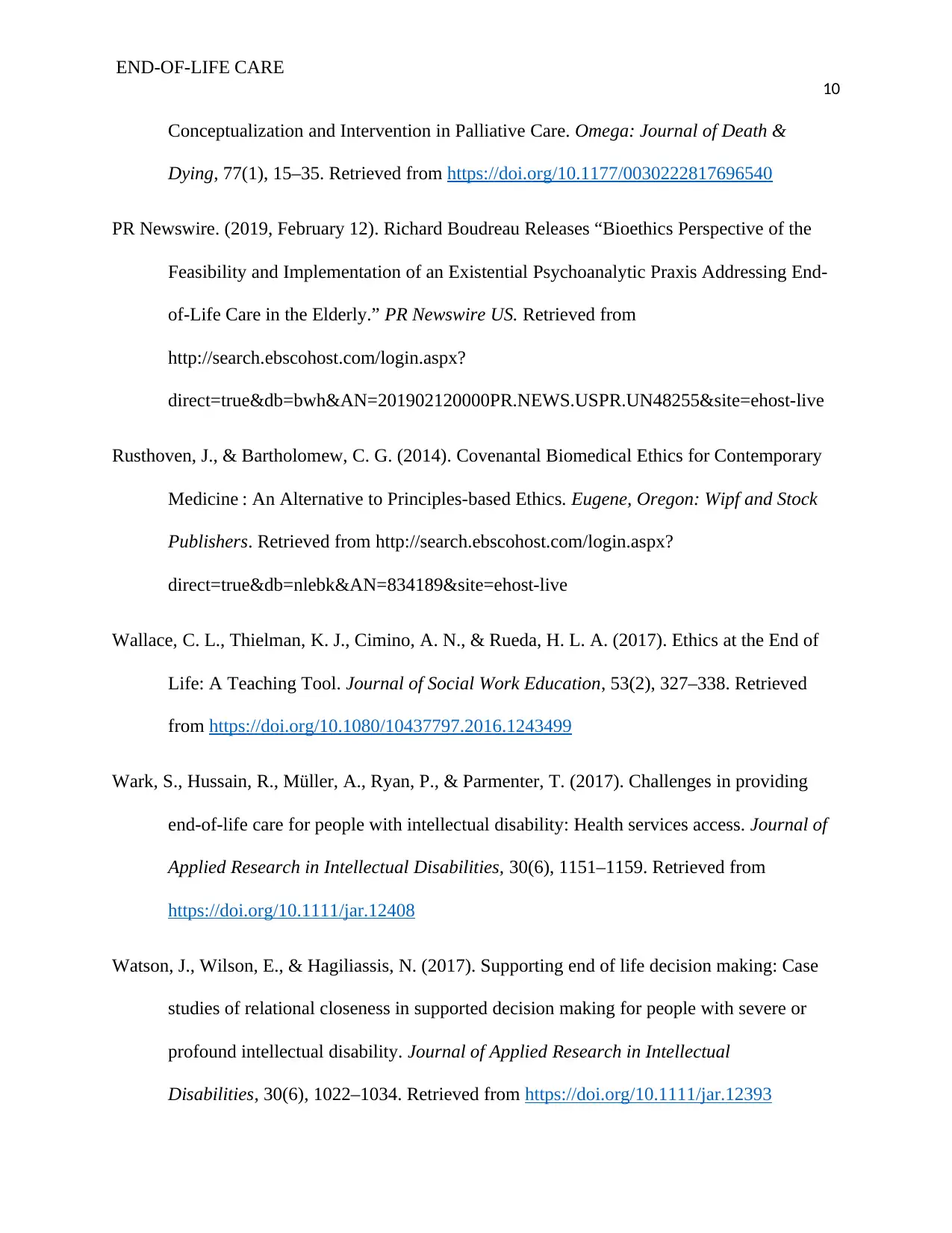
END-OF-LIFE CARE
10
Conceptualization and Intervention in Palliative Care. Omega: Journal of Death &
Dying, 77(1), 15–35. Retrieved from https://doi.org/10.1177/0030222817696540
PR Newswire. (2019, February 12). Richard Boudreau Releases “Bioethics Perspective of the
Feasibility and Implementation of an Existential Psychoanalytic Praxis Addressing End-
of-Life Care in the Elderly.” PR Newswire US. Retrieved from
http://search.ebscohost.com/login.aspx?
direct=true&db=bwh&AN=201902120000PR.NEWS.USPR.UN48255&site=ehost-live
Rusthoven, J., & Bartholomew, C. G. (2014). Covenantal Biomedical Ethics for Contemporary
Medicine : An Alternative to Principles-based Ethics. Eugene, Oregon: Wipf and Stock
Publishers. Retrieved from http://search.ebscohost.com/login.aspx?
direct=true&db=nlebk&AN=834189&site=ehost-live
Wallace, C. L., Thielman, K. J., Cimino, A. N., & Rueda, H. L. A. (2017). Ethics at the End of
Life: A Teaching Tool. Journal of Social Work Education, 53(2), 327–338. Retrieved
from https://doi.org/10.1080/10437797.2016.1243499
Wark, S., Hussain, R., Müller, A., Ryan, P., & Parmenter, T. (2017). Challenges in providing
end-of-life care for people with intellectual disability: Health services access. Journal of
Applied Research in Intellectual Disabilities, 30(6), 1151–1159. Retrieved from
https://doi.org/10.1111/jar.12408
Watson, J., Wilson, E., & Hagiliassis, N. (2017). Supporting end of life decision making: Case
studies of relational closeness in supported decision making for people with severe or
profound intellectual disability. Journal of Applied Research in Intellectual
Disabilities, 30(6), 1022–1034. Retrieved from https://doi.org/10.1111/jar.12393
10
Conceptualization and Intervention in Palliative Care. Omega: Journal of Death &
Dying, 77(1), 15–35. Retrieved from https://doi.org/10.1177/0030222817696540
PR Newswire. (2019, February 12). Richard Boudreau Releases “Bioethics Perspective of the
Feasibility and Implementation of an Existential Psychoanalytic Praxis Addressing End-
of-Life Care in the Elderly.” PR Newswire US. Retrieved from
http://search.ebscohost.com/login.aspx?
direct=true&db=bwh&AN=201902120000PR.NEWS.USPR.UN48255&site=ehost-live
Rusthoven, J., & Bartholomew, C. G. (2014). Covenantal Biomedical Ethics for Contemporary
Medicine : An Alternative to Principles-based Ethics. Eugene, Oregon: Wipf and Stock
Publishers. Retrieved from http://search.ebscohost.com/login.aspx?
direct=true&db=nlebk&AN=834189&site=ehost-live
Wallace, C. L., Thielman, K. J., Cimino, A. N., & Rueda, H. L. A. (2017). Ethics at the End of
Life: A Teaching Tool. Journal of Social Work Education, 53(2), 327–338. Retrieved
from https://doi.org/10.1080/10437797.2016.1243499
Wark, S., Hussain, R., Müller, A., Ryan, P., & Parmenter, T. (2017). Challenges in providing
end-of-life care for people with intellectual disability: Health services access. Journal of
Applied Research in Intellectual Disabilities, 30(6), 1151–1159. Retrieved from
https://doi.org/10.1111/jar.12408
Watson, J., Wilson, E., & Hagiliassis, N. (2017). Supporting end of life decision making: Case
studies of relational closeness in supported decision making for people with severe or
profound intellectual disability. Journal of Applied Research in Intellectual
Disabilities, 30(6), 1022–1034. Retrieved from https://doi.org/10.1111/jar.12393
Paraphrase This Document
Need a fresh take? Get an instant paraphrase of this document with our AI Paraphraser
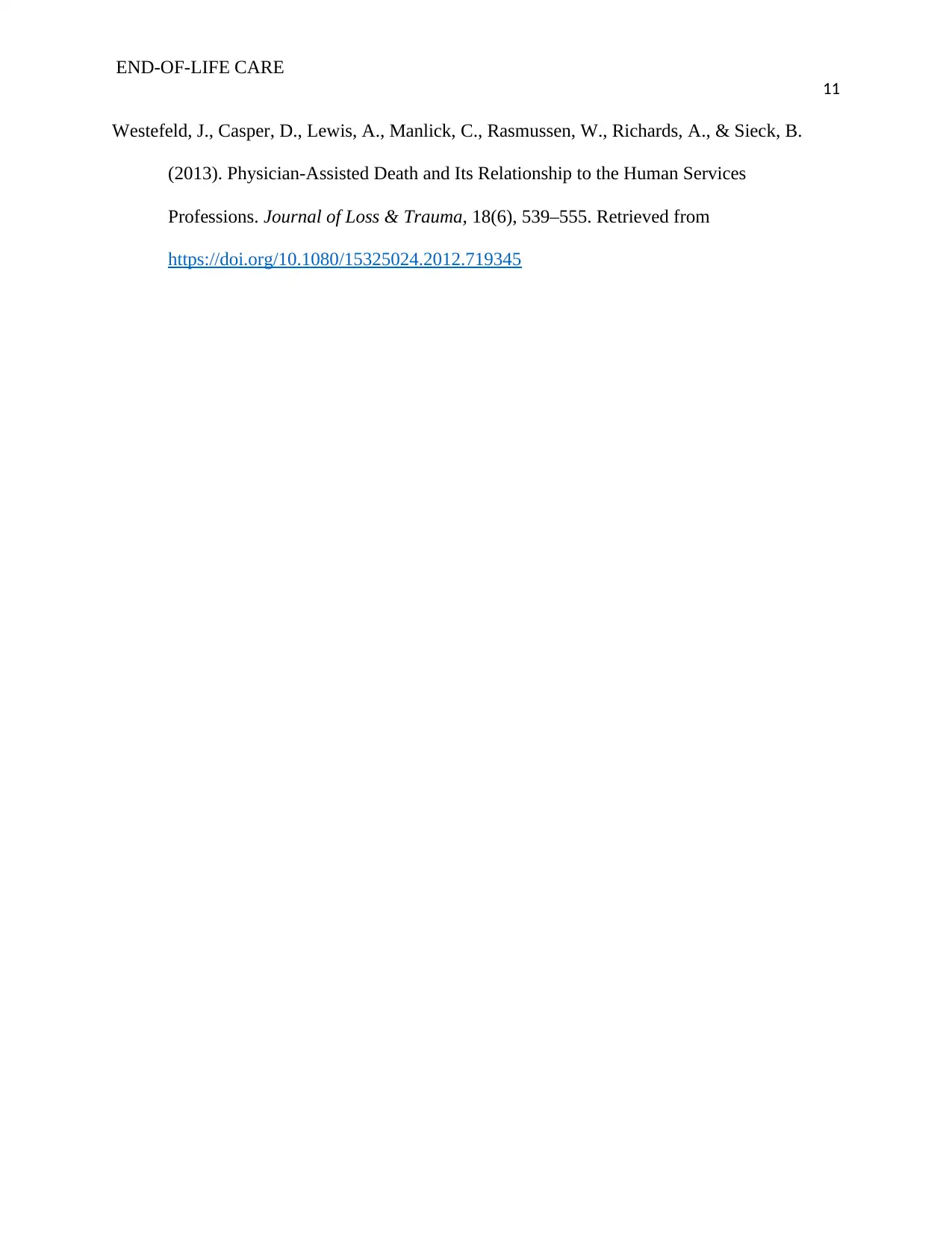
END-OF-LIFE CARE
11
Westefeld, J., Casper, D., Lewis, A., Manlick, C., Rasmussen, W., Richards, A., & Sieck, B.
(2013). Physician-Assisted Death and Its Relationship to the Human Services
Professions. Journal of Loss & Trauma, 18(6), 539–555. Retrieved from
https://doi.org/10.1080/15325024.2012.719345
11
Westefeld, J., Casper, D., Lewis, A., Manlick, C., Rasmussen, W., Richards, A., & Sieck, B.
(2013). Physician-Assisted Death and Its Relationship to the Human Services
Professions. Journal of Loss & Trauma, 18(6), 539–555. Retrieved from
https://doi.org/10.1080/15325024.2012.719345
1 out of 11
Related Documents
Your All-in-One AI-Powered Toolkit for Academic Success.
+13062052269
info@desklib.com
Available 24*7 on WhatsApp / Email
![[object Object]](/_next/static/media/star-bottom.7253800d.svg)
Unlock your academic potential
Copyright © 2020–2025 A2Z Services. All Rights Reserved. Developed and managed by ZUCOL.




